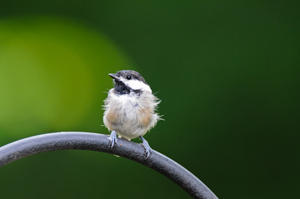Chickadees - Nature’s Backyard Charmer
Chickadees may be the one of the most beloved birds that visit our backyards, but their seemingly never-ending energy and inquisitive nature are only part of what makes these birds fun to watch.

- Chickadees are inquisitive and found in wooded areas across much of North America. The more common species include the Black-capped, Carolina and Mountain Chickadees. Here in our part of the globe, we have the Carolina Chickadee.
- Chickadees are easily identified by their namesake call “chick-a-dee-dee-dee.”
- Chickadees weigh less than half an ounce.
- In early summer, Mountain Chickadees are able to find and eat seeds they hid during the previous autumn.
- Chestnut-backed and Black-capped Chickadees watch other birds’ foraging habits to see if they should adapt their behavior to be more successful.
- Boreal Chickadees' winter-cached foods are most often stored lower on the tree in which they were found but high enough above common snow lines.
- Chickadees are generally monogamous and stay with the same mate for life.
- Chickadees are cavity nesters and will excavate their own nest site in rotten or decaying wood or use an old woodpecker hole or use a nesting box. (Mountain chickadees may nest under rock in a bank or in a hole in the ground.)
- Though chickadees are regular visitors to feeders, over 75% of their winter food supply still comes from natural sources.
- Chickadees do not migrate and are equipped to survive harsh winter weather. They cache foods and remember where they are hidden, have dense winter coats, diligently find excellent, well-insulated roosting cavities and can perform a regulated hypothermia to conserve energy overnight.
- \When the temperature falls below 10º F, research has shown that the survival rate of chickadees almost doubled when they had access to feeders.
- Chickadees can gain as much as 10% of their body weight each day and lose it all again during a cold winter night.
